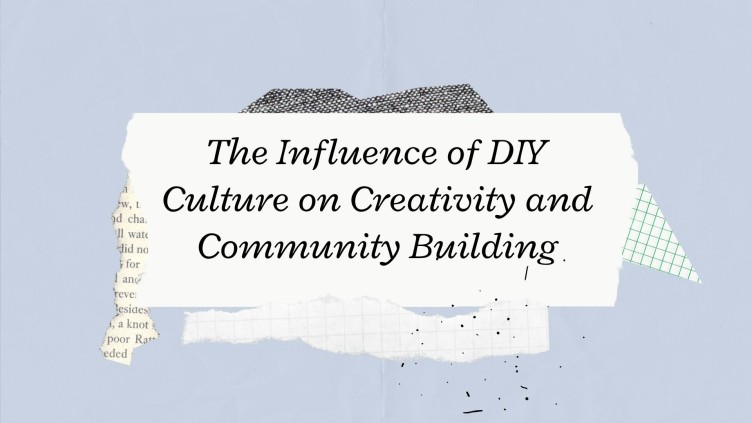In the age of hashtags and viral challenges, there’s a quieter revolution brewing—one that champions creativity, community, and empowerment in a profoundly personal way. DIY culture, short for “Do It Yourself,” isn’t just about making things; it’s about redefining how we engage with creativity and connect with others in our communities. From handmade crafts to artisanal goods, from backyard mechanics to indie music scenes, the impact of DIY culture is as diverse as it is profound.
What is DIY Culture?
At its core, DIY culture is about reclaiming agency over the things we create and consume. It’s a rejection of mass-produced uniformity in favor of personalized expression. Think of the local artisan who handcrafts leather goods, the amateur musician recording tracks in their bedroom studio, or the community garden where neighbors grow organic produce together. DIY encompasses a wide spectrum of activities, united by a common ethos: the desire to create, share, and collaborate on a grassroots level.
Creativity Unleashed
One of the most significant impacts of DIY culture is its ability to unleash creativity. When individuals take matters into their own hands, they bypass traditional gatekeepers and commercial constraints. This freedom fosters experimentation and innovation, leading to a rich tapestry of artistic endeavors.
Take the resurgence of vinyl records, for example. Despite the digital music revolution, vinyl sales have skyrocketed in recent years. DIY enthusiasts have not only revived interest in analog music but also created a market for independent artists and small labels. Bands that once struggled to be heard amidst mainstream noise now find dedicated audiences through vinyl enthusiasts and DIY distribution channels.
Another compelling example is the rise of independent publishing. Platforms like Etsy and Kickstarter have democratized the process of bringing creative projects to life. Writers, illustrators, and photographers can self-publish books, zines, and art prints with minimal upfront costs, reaching global audiences without traditional publishing gatekeepers.
Community Building and Social Impact
Beyond individual creativity, DIY culture fosters community building and social impact. By its very nature, DIY encourages collaboration, skill-sharing, and mutual support. Local DIY workshops, maker spaces, and community studios provide shared resources and a supportive environment for creators of all ages and backgrounds.
For instance, the Maker Movement has transformed how communities approach education and innovation. Schools and libraries across the globe now host maker fairs and workshops where students and adults alike can learn electronics, coding, woodworking, and more. These hands-on experiences not only teach practical skills but also nurture problem-solving abilities and a sense of empowerment.
Moreover, DIY initiatives often have a positive environmental impact. Upcycling and repurposing materials reduce waste and promote sustainability. Projects like community gardens not only provide fresh produce but also strengthen neighborhood bonds and promote healthier lifestyles.
DIY in the Digital Age
The internet and social media have been catalysts for the DIY revolution, amplifying its reach and impact. Platforms like YouTube and Instagram are teeming with DIY tutorials, from home improvement hacks to gourmet cooking recipes. Online communities form around shared interests, providing feedback, encouragement, and inspiration across borders and time zones.
In recent years, social media platforms have also been instrumental in mobilizing DIY efforts for social causes. From fundraising campaigns to awareness-raising projects, individuals and groups harness digital tools to effect change in their communities and beyond. For example, the “Little Free Library” movement began as a grassroots initiative to promote literacy and community engagement through small book exchanges. Today, there are thousands of Little Free Libraries worldwide, each a testament to the power of DIY to foster positive change.
Conclusion: Embracing DIY Culture
In conclusion, DIY culture is not just a trend but a transformative force with enduring relevance. It empowers individuals to reclaim their creativity, connect with others authentically, and make meaningful contributions to their communities. Whether through traditional crafts or cutting-edge technology, the spirit of DIY continues to inspire and unite people worldwide.
As we navigate an increasingly digital and interconnected world, the principles of DIY—creativity, community, and empowerment—serve as guiding lights. By celebrating and supporting DIY culture, we not only enrich our own lives but also contribute to a more vibrant, inclusive society where everyone has the opportunity to create and thrive.
So, whether you’re tinkering in your garage, starting a community garden, or launching a handmade business online, remember: the power to make a difference lies in your hands. Embrace the DIY spirit, and watch as creativity blooms and communities flourish around you.
Let’s continue to DIY—and do it together.







